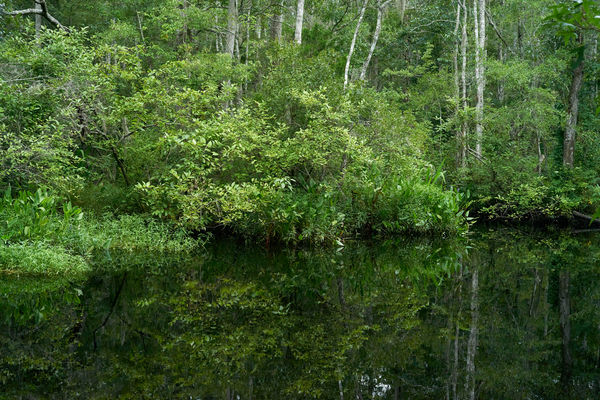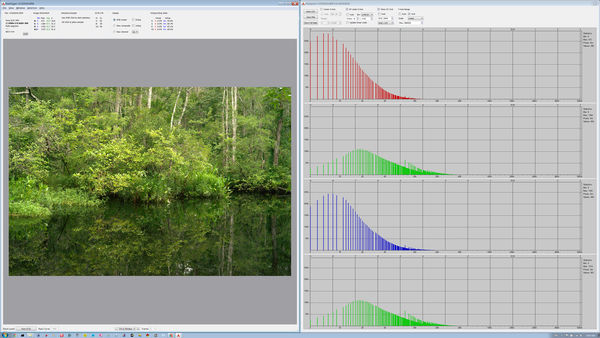Severe underexposure
Jul 7, 2018 09:16:02 #
I deliberately underexposed this scene by about 4 stops.
The image was taken with a 24 MP Sony A7 II, a 50 mm Leica Summicron Rigid at ISO 200, 1/1000 sec at f/11 (Sunny 16). It's clearly not broad daylight.
This image should not have been possible according to proponents of ETTR. What's more, RawDigger indicates that the raw histogram is grossly shifted to the left.
But I was still able to recover a decent image simply by using the Exposure slider in Capture One. Other raw converters would have worked as well.
I don't recommend that much underexposure.
The image was taken with a 24 MP Sony A7 II, a 50 mm Leica Summicron Rigid at ISO 200, 1/1000 sec at f/11 (Sunny 16). It's clearly not broad daylight.
This image should not have been possible according to proponents of ETTR. What's more, RawDigger indicates that the raw histogram is grossly shifted to the left.
But I was still able to recover a decent image simply by using the Exposure slider in Capture One. Other raw converters would have worked as well.
I don't recommend that much underexposure.
Jul 7, 2018 09:36:52 #
I'm not sure of what you are trying to assert here. Underexposure of 4 stops is quite manageable, as you've shown here. As you also noted, it's not something that should be recommended. I'll just leave it at that.
--Bob
--Bob
selmslie wrote:
I deliberately underexposed this scene by about 4 ... (show quote)
Jul 7, 2018 09:40:23 #
Jul 7, 2018 09:42:05 #
rmalarz wrote:
I'm not sure of what you are trying to assert here. ...
I think you know exactly what I am implying - that ETTR would not have made a visible difference in this case.
This is a real image, not a theory.
Jul 7, 2018 09:47:38 #
AzPicLady wrote:
I guess I'm curious as to why you chose to underexpose the frame.
I was testing the limits of Sunny 16 which recommends a net exposure value (EV) of 14.7 for full sunlight. I normally use EV 15 in full sun to protect any highlights.
For a scene like this in full shade the net EV should have been about 11 or 12 and that’s what the camera’s meter was telling me.
Jul 7, 2018 10:13:10 #
Why limit yourself to one side of the question? ETTR is concerned about (nearly) overexposing. By definition, underexposing has nothing to do with the ETTR technique. Where is your comparative example with the RAW highlights pushed to the right and then the corresponding edits to lower the exposure? Then, you just might have something worthwhile for a comparison of the final results compared to correcting an underexposed image.
All this example shows is the ability to recover underexposure and none of the other baggage you've attempted to demonstrate / disprove.
All this example shows is the ability to recover underexposure and none of the other baggage you've attempted to demonstrate / disprove.
Jul 7, 2018 10:22:07 #
selmslie wrote:
I think you know exactly what I am implying - that ETTR would not have made a visible difference in this case.
This is a real image, not a theory.
This is a real image, not a theory.
You seem to be the one who has prejudged against an expected result with no actual demonstration of an inferior result from an alternative technique. To say it 'would' make no difference, where is your demonstration it does make no difference?
The shadows and overall image are very clean at ISO-200. More so than I would expect from a result pushed by +4 in post. That aspect of the demonstration is worthwhile. Although, I'd attribute the result to be influenced more by the specific camera / sensor rather than a general guideline of 'underexposure doesn't matter'.
Jul 7, 2018 11:21:18 #
CHG_CANON wrote:
... To say it 'would' make no difference, where is your demonstration it does make no difference? ....
It's not a casual comment. Do you see anything wrong with the image?
Since the image is free of defects as a result of underexposure, there are no shortcomings to overcome by adding exposure to get a normal or even an ETTR/EBTR exposure.
I don't need to demonstrate that it makes no difference. Someone else needs to demonstrate that it does. That has never happened. All we have seen are theories - why it should make a difference - and exhibits using wildly inappropriate ISO settings.
I have already demonstrated that manual exposure following closely the Sunny 16 recommendation for broad daylight actually accomplishes two things - the highlights are unlikely to be blown and the result is close to a natural ETTR exposure in a wide DR scene if it contains bright white clouds, white feathers or white foam on surf. If the scene's DR is narrow, a Sunny 16 does no harm at all because both the shadows and the highlights are closer to middle gray.
Take a look at https://www.uglyhedgehog.com/t-536510-4.html#9105423 and https://www.uglyhedgehog.com/t-536138-2.html#9095458
Consider also another benefit of Sunny 16. It is relatively effortless compared to what you need to go through to accomplish ETTR/EBTR.
Jul 8, 2018 08:42:15 #
One of the benefits of using digital images is that the shadow areas are pretty flexible, as you have just demonstrated. Where you cannot make mistakes is in exposing the bright areas, the main reason why it is recommended to ALWAYS expose for those bright areas that are important in the final image.
I agree with you, underexposing by that much is not recommended. In case it matters, I like to make sure that I am using all the pixels that will make a significant contribution to my shot. In some cases I expose to the right (ETTR) on purpose while others I just look at the histogram to make sure I have the best exposure for my subjects and usually that exposure is slightly short of a full ETTR.
I agree with you, underexposing by that much is not recommended. In case it matters, I like to make sure that I am using all the pixels that will make a significant contribution to my shot. In some cases I expose to the right (ETTR) on purpose while others I just look at the histogram to make sure I have the best exposure for my subjects and usually that exposure is slightly short of a full ETTR.
Jul 8, 2018 09:20:28 #
camerapapi wrote:
One of the benefits of using digital images is that the shadow areas are pretty flexible, as you have just demonstrated. Where you cannot make mistakes is in exposing the bright areas, the main reason why it is recommended to ALWAYS expose for those bright areas that are important in the final image. ...
Exactly right.
Here are a few things that are often overlooked:
1. Increasing the exposure (usually by lowering the shutter speed) is not the only way to move the histogram to the right. If you are not already at base ISO, reducing the ISO accomplishes the same thing.
2. Since lowering the ISO moves the histogram to the right, the only time you need to resort to reducing the shutter speed is when you are already at base ISO. In other words, ETTR by reducing the shutter speed should only be used at base ISO.
3. As I have mentioned before, the brightness of the sun in broad daylight is a constant. You don't ever need to meter it (or white clouds, feathers, sea foam, etc) because you will always get the same reading. Since all of this is constant, Sunny 16 or a net EV of 15 will always give you a good exposure without blowing highlights.
4. The camera's JPEG histogram is too small to really judge how far you can move to the right. Highlight warnings (blinkies) are easier to use.
5. Moving the histogram to the right only increases the numeric values recorded in the raw file. For example, a one stop change will double all of the numeric values. But as you can see in the above RawDigger exhibit, changing the numeric values has very little visible effect on the image rendition. Theoretically, the shadows should have suffered but can you see it?
6. Finally, as Gene51 pointed out in another thread, ETTR does not always result in moving the histogram to the right making the JPEG brighter. In a scene with a very wide DR, you may need to move the histogram to the left to avoid blowing the highlights and that will make the JPEG darker.
Jan 11, 2019 15:15:47 #
selmslie wrote:
I deliberately underexposed this scene by about 4 ... (show quote)
A very appealing image. Thanks.
Jan 11, 2019 15:17:20 #
rmalarz wrote:
I'm not sure of what you are trying to assert here. Underexposure of 4 stops is quite manageable, as you've shown here. As you also noted, it's not something that should be recommended. I'll just leave it at that.
--Bob
--Bob

If you want to reply, then register here. Registration is free and your account is created instantly, so you can post right away.







